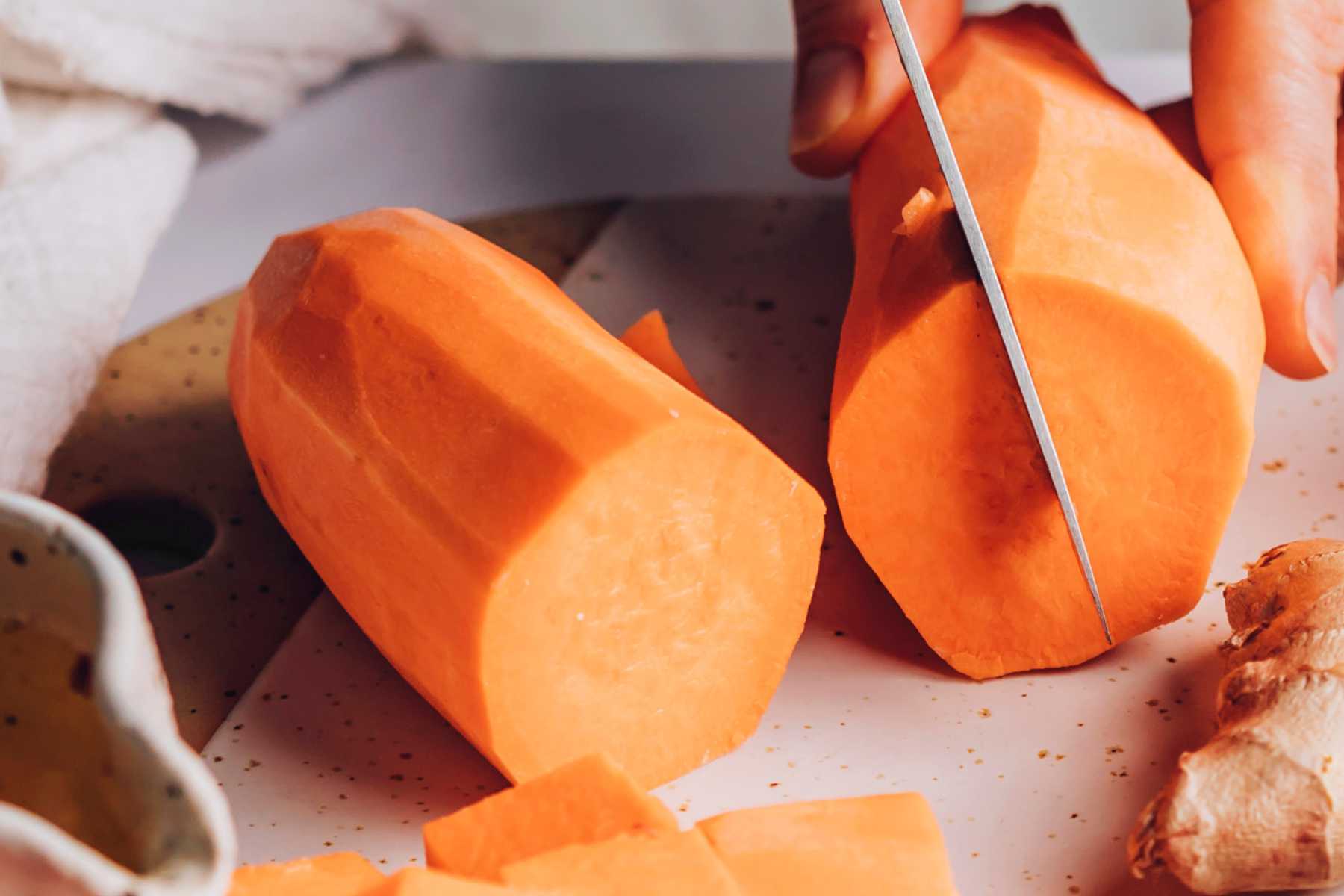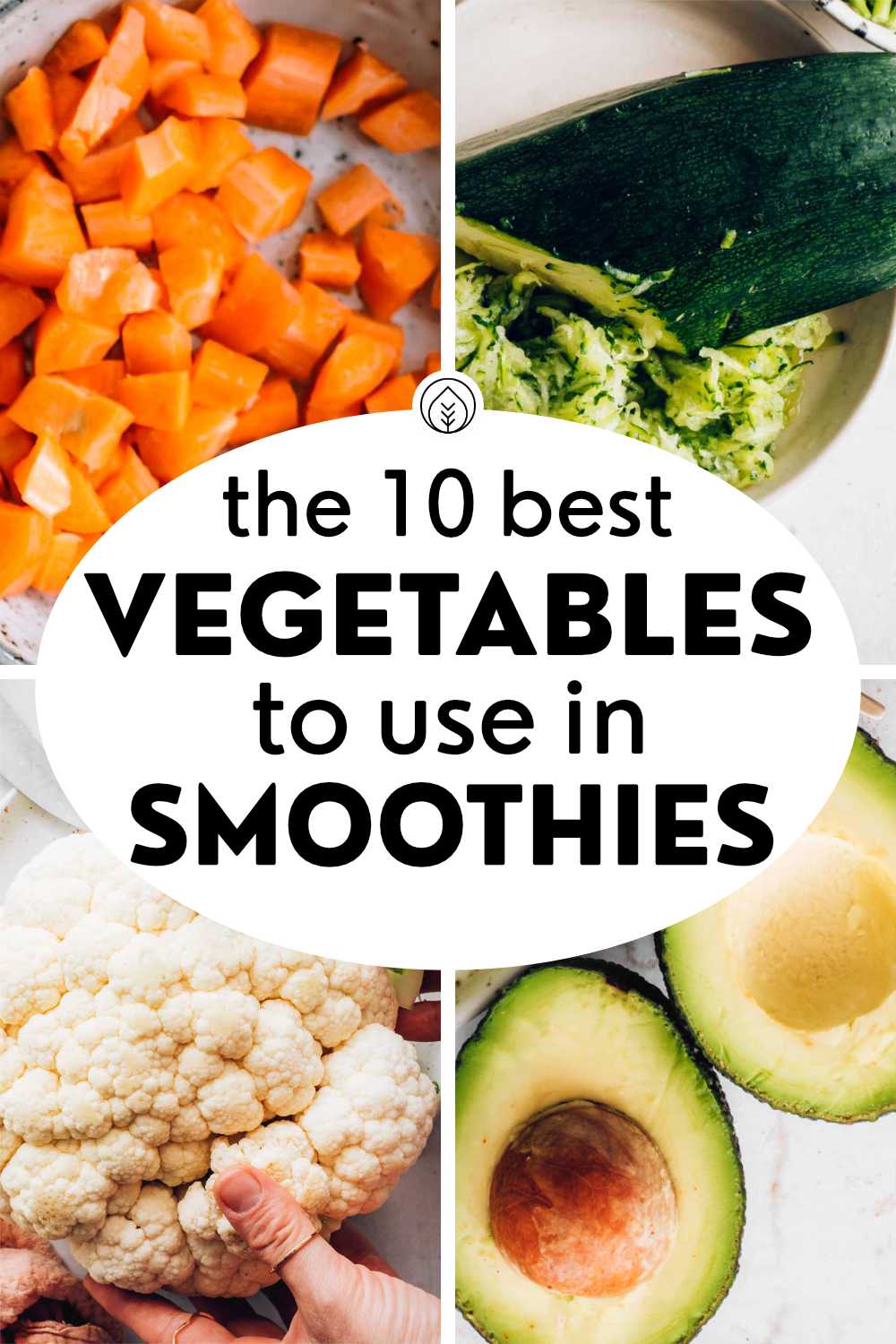Adding veggies to your smoothies is a quick & easy way to add more nutrients to your diet. You won’t even taste them (unless you add a lot!) The sweet fruits will overpower any vegetable taste.

free 7-day vegan meal plan
Your next week of eating is planned out with these quick and delicious vegan bowls, meal prepping steps & full grocery list.
Our bean berry smoothie uses frozen cauliflower and you can’t tell at all. We love how creative we can get with smoothies.
Let’s dive into the best veggies for your smoothies, and check out our article on how to eat more veggies next!

Avocado
Okay, Avocado is technically a fruit but it doesn’t have the same sweetness (so that’s why we’re categorizing it as a vegetable). Avocados are super creamy and will add a velvety texture to your smoothie.
Use half to a whole avocado, depending on how large your smoothie will be. Fresh avocado will result in a vibrant green color, but you can use frozen avocado chunks if you want a thicker consistency.
Avocados are rich in healthy fats and fiber, making them the perfect addition to your smoothie.
Beets
If you want a gorgeous pink hue to your smoothie, beets are your best friend! They have a vegetal yet slightly sweet taste that pairs well with many fruits.
We recommend using precooked beets — this will save you a lot of prep time (smoothies should be simple to make after all). Precooked beets also blend a lot smoother.
Simply add a few beet slices at a time to get your desired color and taste. The benefits: extra antioxidants, fiber, and nutrients!

Cauliflower
Cauliflower in a smoothie? I know it sounds strange, but just trust us! It’s a great way to add some creaminess and thickness to your smoothie without changing the flavor.
Use about ½ cup of frozen cauliflower in one smoothie. We don’t recommend fresh cauliflower because it does not blend as well.
Cauliflower is low calorie and contains fiber, vitamins, and minerals such as vitamin C and potassium.
Broccoli
Another strange one, we know! Broccoli is added to the list because it’s rich in fiber, vitamin C, vitamin K1, folate, and more.
You can add ½ cup of fresh or raw broccoli to your smoothie. If using fresh, make sure you use frozen fruit alongside it so you can get the best texture.
Check out our delicious broccoli smoothie! It’s tried and tested for optimal taste.

Carrots
Besides adding a lovely orange color, carrots have a subtle, natural sweetness that’s ideal for smoothies. Frozen carrots blend very smoothly — fresh carrots can work, but it’s harder to get an even consistency.
Add about a ½ cup of frozen carrot slices to your smoothie!
Carrots give you a boost of beta-carotene, vitamin A, vitamin C, potassium, and fiber. These vitamins and minerals help promote eye health and healthy digestion.
Cucumber
You’ve probably had cucumber in a green smoothie before! Since they’re composed of a high percentage of water, they won’t affect the taste much.
Use half of a fresh or frozen cucumber (peeled or unpeeled). Fresh cucumber will give you a more watery smoothie, while frozen will yield a thicker texture.
Cucumbers in your smoothie will provide hydration and some vitamin K!

Kale
Another classic ingredient found in green smoothies — kale is rich in antioxidants, vitamins (A, C and K), and minerals. When paired with fruit, you can’t taste it at all!
Simply add a handful of fresh or frozen kale (no stems) and blend. Fresh kale will result in a smoother texture, while frozen can make an icier one.
Spinach
Like kale, spinach has a mild flavor packed with nutrients. It’s probably the most commonly added vegetable in smoothies!
Add a handful of fresh or frozen spinach, and you’ll get a yummy treat packed with iron, vitamin A, vitamin K, and fiber.
With lighter fruits, adding spinach will make your smoothie a light green. With darker fruits, like berries, adding spinach may create a brown color. But don’t worry, it’s the taste that counts :)

Sweet potato
As its name suggests, sweet potatoes have a natural sweetness that’s perfect for adding to smoothies. It can also add a warm orange color, too!
We recommended using cooked sweet potato — it will blend like a dream. You’ll get a nice, velvety texture plus a dose of beta-carotene. Sweet potatoes also contain vitamin C, potassium, and fiber!
Tip: add a dash of cinnamon and nutmeg, and you can recreate a sweet potato pie flavor.
Zucchini
Last but not least, zucchini! Zucchini has a pretty mild flavor, so try out different combinations of fruit and see what you like!
Incorporate about ½ cup of frozen zucchini (peeled or unpeeled) for a thick, creamy consistency.
Since zucchini has a high water content, you’ll be getting some hydration plus added fiber, vitamin C, and vitamin K.

Final tips
Experiment! Everyone has different taste preferences, so add more or less veggies to your smoothies as you please. If you don’t know where to start, we love using frozen bananas and adding our favorite fruits. Good luck!
Wanna try a smoothie?
Did you find our best vegetables for smoothies article helpful? Share it with your friends, Pin it here, and leave a comment below!




 Alena Schowalter is a Certified Vegan Nutritionist who has been a vegetarian since childhood and vegan since 2012. Together with her husband, she founded nutriciously in 2015 and has been guiding thousands of people through different transition stages towards a healthy plant-based diet. She’s received training in the fields of nutrition, music therapy and social work. Alena enjoys discussions around vegan ethics, walks through nature and creating new recipes.
Alena Schowalter is a Certified Vegan Nutritionist who has been a vegetarian since childhood and vegan since 2012. Together with her husband, she founded nutriciously in 2015 and has been guiding thousands of people through different transition stages towards a healthy plant-based diet. She’s received training in the fields of nutrition, music therapy and social work. Alena enjoys discussions around vegan ethics, walks through nature and creating new recipes.
From leafy greens to zucchini, these are the 10 best vegetables for smoothies. We promise that they won’t change the taste if you follow our tips!